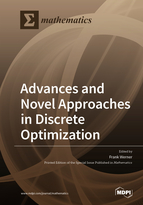Advances and Novel Approaches in Discrete Optimization
A special issue of Mathematics (ISSN 2227-7390). This special issue belongs to the section "Mathematics and Computer Science".
Deadline for manuscript submissions: closed (15 June 2020) | Viewed by 47552
Special Issue Editor
Interests: scheduling; development of exact and approximate algorithms; stability investigations; discrete optimization; scheduling with interval processing times; complex investigations for scheduling problems; train scheduling; graph theory; logistics; supply chains; packing; simulation; applications
Special Issues, Collections and Topics in MDPI journals
Special Issue Information
Dear Colleagues,
We invite you to submit your latest research in the area of discrete optimization to this Special Issue, “Advances and Novel Approaches in Discrete Optimization”, in the journal Mathematics. We are looking for new and innovative approaches for exactly or approximately solving discrete optimization problems. High-quality papers are solicited to address both theoretical and practical issues in discrete optimization. Submissions are welcome presenting new theoretical results, structural investigations, new models and algorithmic approaches, as well as new applications of discrete optimization problems. Potential topics include, but are not limited to, integer programming, combinatorial optimization, graphs and networks, scheduling, logistics, and transportation.
Prof. Dr. Frank Werner
Guest Editor
Manuscript Submission Information
Manuscripts should be submitted online at www.mdpi.com by registering and logging in to this website. Once you are registered, click here to go to the submission form. Manuscripts can be submitted until the deadline. All submissions that pass pre-check are peer-reviewed. Accepted papers will be published continuously in the journal (as soon as accepted) and will be listed together on the special issue website. Research articles, review articles as well as short communications are invited. For planned papers, a title and short abstract (about 100 words) can be sent to the Editorial Office for announcement on this website.
Submitted manuscripts should not have been published previously, nor be under consideration for publication elsewhere (except conference proceedings papers). All manuscripts are thoroughly refereed through a single-blind peer-review process. A guide for authors and other relevant information for submission of manuscripts is available on the Instructions for Authors page. Mathematics is an international peer-reviewed open access semimonthly journal published by MDPI.
Please visit the Instructions for Authors page before submitting a manuscript. The Article Processing Charge (APC) for publication in this open access journal is 2600 CHF (Swiss Francs). Submitted papers should be well formatted and use good English. Authors may use MDPI's English editing service prior to publication or during author revisions.
Keywords
- nonlinear and linear integer programming
- optimization problems on graphs and networks
- combinatorial optimization
- scheduling
- optimization in logistics and transport
- robust discrete optimization
- optimization under uncertainty
- polyhedral combinatorics
- complexity issues
- branch and bound, cutting-plane methods, dynamic programming
- approximation and randomized algorithms
- online algorithms
- advanced heuristics, metaheuristics, and matheuristics
- constraint programming
- interior point methods
- decomposition methods






